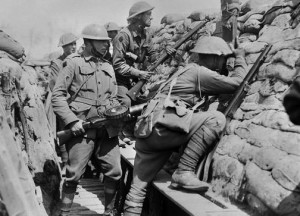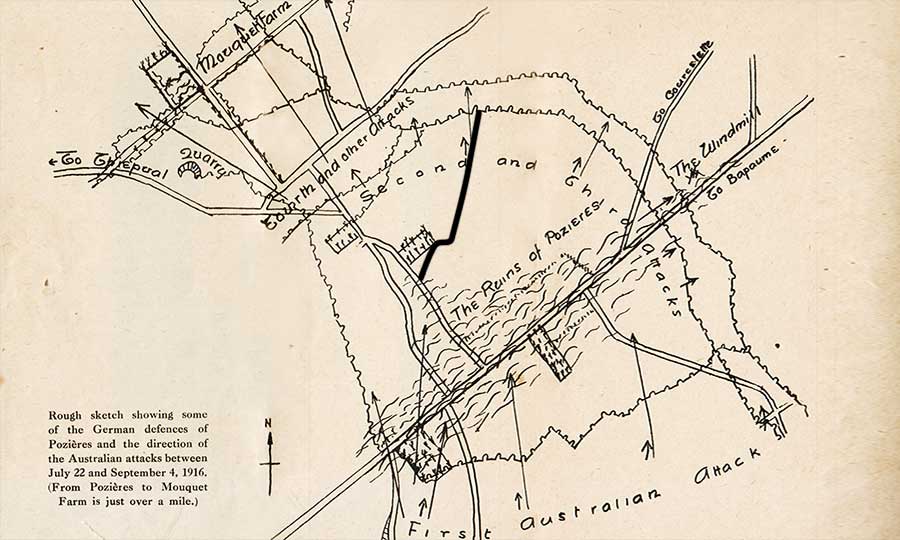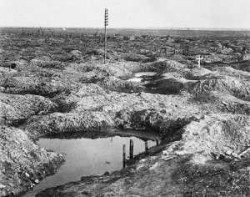The Battle for Pozières
 Following the bloody initiation of the 5th Division at Fromelles, the next major test for the AIF was not far off. It would come on the Somme Front, involving the 1st, 2nd and 4th Australian Divisions, and the fighting would include now-famous sites - Pozières, the Windmill and Mouquet Farm. In this highlight, as we continue to follow the Australians across the Western Front, we will concentrate on the first of these actions - the capture of the village of Pozières.
A farming community straddling the Albert - Bapaume road, Pozières occupied a major spur running south-west off the main Pozières Ridge. The Germans had incorporated the village into their front line. Apart from other works, it contained something outside of
Following the bloody initiation of the 5th Division at Fromelles, the next major test for the AIF was not far off. It would come on the Somme Front, involving the 1st, 2nd and 4th Australian Divisions, and the fighting would include now-famous sites - Pozières, the Windmill and Mouquet Farm. In this highlight, as we continue to follow the Australians across the Western Front, we will concentrate on the first of these actions - the capture of the village of Pozières.
A farming community straddling the Albert - Bapaume road, Pozières occupied a major spur running south-west off the main Pozières Ridge. The Germans had incorporated the village into their front line. Apart from other works, it contained something outside of  the Australians’ Gallipoli experience – a multi-storey concrete blockhouse, nicknamed “Gibraltar”, covering all likely approaches at the south-western end of the village. Beyond Pozières the German second line and support line trenches (OG1 and OG2) ran along the ridge, with the Windmill further back on the crest.
The high ground of the Pozières Ridge had been an objective of the British 4th Army at the opening of General Haig’s Somme Offensive on 1 July 1916, but was not taken. A second 4th Army attack on 14 July captured some of the German second line on the right flank, but Pozières remained as a threat to the left of the British advance. To leave the 4th Army free to concentrate on a further attack, supported by the French on the right, General Gough’s Reserve Army was given responsibility for reducing Pozières. Gough was allocated the 1st Australian Division as reinforcements.
The 1st Division began to move up from its assembly area near Amiens on 16 July and, on the 18th, Gough decided that it should attack Pozières the following night! With the division still concentrating and no time for proper battle procedure the commander, Major General Walker, argued for and got a 24 hour delay. After further representations from General Birdwood, the attack was set for 12.30 am on 23 July, to coincide with the 4th Army advance on the right. Next, Walker was successful in getting the axis of the attack changed, from a frontal, south-western approach to one from the south-east. This acheter viagra would prevent his left flank being exposed to the German lines on the high ground, while his right would be covered by the 4th Army advance.
the Australians’ Gallipoli experience – a multi-storey concrete blockhouse, nicknamed “Gibraltar”, covering all likely approaches at the south-western end of the village. Beyond Pozières the German second line and support line trenches (OG1 and OG2) ran along the ridge, with the Windmill further back on the crest.
The high ground of the Pozières Ridge had been an objective of the British 4th Army at the opening of General Haig’s Somme Offensive on 1 July 1916, but was not taken. A second 4th Army attack on 14 July captured some of the German second line on the right flank, but Pozières remained as a threat to the left of the British advance. To leave the 4th Army free to concentrate on a further attack, supported by the French on the right, General Gough’s Reserve Army was given responsibility for reducing Pozières. Gough was allocated the 1st Australian Division as reinforcements.
The 1st Division began to move up from its assembly area near Amiens on 16 July and, on the 18th, Gough decided that it should attack Pozières the following night! With the division still concentrating and no time for proper battle procedure the commander, Major General Walker, argued for and got a 24 hour delay. After further representations from General Birdwood, the attack was set for 12.30 am on 23 July, to coincide with the 4th Army advance on the right. Next, Walker was successful in getting the axis of the attack changed, from a frontal, south-western approach to one from the south-east. This acheter viagra would prevent his left flank being exposed to the German lines on the high ground, while his right would be covered by the 4th Army advance.
 The Australians also sought a further modification to the plan. Rather than attack in two phases, over two nights, which would allow the Germans time to react, it was proposed to push the assault into the centre of the village, as far as the Albert – Bapaume road, on the first night. This change was approved and the division prepared to attack with the 1st and 3rd Brigades in line and the 2nd Brigade as the divisional reserve.
Under cover of darkness saps were dug to establish forward positions from which the assault could be launched, reducing the distance over open ground to the German trenches. Artillery preparation began on 19 July and, at 10.00 pm on 22 July, increased to an intensity not previously seen by the Australians. Assault battalions moved up into the saps by midnight and, at 12.10 am, crawled further forward to lay up along marking tapes set out previously by unit scouts.
At 12.30 am the covering fire lifted onto the intermediate objective and the German forward line, Pozières Trench, fell quickly to the first assault wave. The second wave, on moving through, found that the intermediate objective, New Trench, was incomplete and posed no obstacle. Passing through in turn, the third wave met with mixed results. On the left troops quickly reached the line of the Albert – Bapaume road but progress on the right was stopped by strong German resistance in the area of the OG 1 trench, leaving a 450 m gap between the two wings of the 1st Division attack. At 5.30 am a German counter-attack was funnelled into this gap, where machine gun and artillery fire halted it, then drove it back.
The Australians also sought a further modification to the plan. Rather than attack in two phases, over two nights, which would allow the Germans time to react, it was proposed to push the assault into the centre of the village, as far as the Albert – Bapaume road, on the first night. This change was approved and the division prepared to attack with the 1st and 3rd Brigades in line and the 2nd Brigade as the divisional reserve.
Under cover of darkness saps were dug to establish forward positions from which the assault could be launched, reducing the distance over open ground to the German trenches. Artillery preparation began on 19 July and, at 10.00 pm on 22 July, increased to an intensity not previously seen by the Australians. Assault battalions moved up into the saps by midnight and, at 12.10 am, crawled further forward to lay up along marking tapes set out previously by unit scouts.
At 12.30 am the covering fire lifted onto the intermediate objective and the German forward line, Pozières Trench, fell quickly to the first assault wave. The second wave, on moving through, found that the intermediate objective, New Trench, was incomplete and posed no obstacle. Passing through in turn, the third wave met with mixed results. On the left troops quickly reached the line of the Albert – Bapaume road but progress on the right was stopped by strong German resistance in the area of the OG 1 trench, leaving a 450 m gap between the two wings of the 1st Division attack. At 5.30 am a German counter-attack was funnelled into this gap, where machine gun and artillery fire halted it, then drove it back.
 While the Australians had been successful, the main 4th Army attack had stalled. Haig opted for local assaults to wear down the defenders until the main offensive could resume. The Germans, however, were planning a major effort to regain the critical Pozières position, timed for 4.30 pm on 25 July. It was to be supported by a full artillery bombardment commencing on the morning of the 24th. Meanwhile the 1st Division was preparing two operations of its own. Gough had ordered Walker to secure an area beyond the Pozières cemetery for later operations against the OG 1 and OG 2 lines north of the Albert - Bapaume road. Walker had already planned an attack to capture the section of the OG 1 trench that had not been taken in the initial assault on 23 July. Despite the German bombardment, these attacks were launched, 90 minutes apart, in the early morning hours of 25 July.
The attack on the OG 1 trench by the 5th Battalion gained part of the objective after initial confusion. However a German counter-attack developed into a three hour bombing fight, drawing in the 7th, 9th and 10th Battalions before the Germans withdrew. In the other action, the 4th and 8th Battalions were successful in fighting their way to the
While the Australians had been successful, the main 4th Army attack had stalled. Haig opted for local assaults to wear down the defenders until the main offensive could resume. The Germans, however, were planning a major effort to regain the critical Pozières position, timed for 4.30 pm on 25 July. It was to be supported by a full artillery bombardment commencing on the morning of the 24th. Meanwhile the 1st Division was preparing two operations of its own. Gough had ordered Walker to secure an area beyond the Pozières cemetery for later operations against the OG 1 and OG 2 lines north of the Albert - Bapaume road. Walker had already planned an attack to capture the section of the OG 1 trench that had not been taken in the initial assault on 23 July. Despite the German bombardment, these attacks were launched, 90 minutes apart, in the early morning hours of 25 July.
The attack on the OG 1 trench by the 5th Battalion gained part of the objective after initial confusion. However a German counter-attack developed into a three hour bombing fight, drawing in the 7th, 9th and 10th Battalions before the Germans withdrew. In the other action, the 4th and 8th Battalions were successful in fighting their way to the  Pozières cemetery, clearing the remainder of the village in the process. The planned attack to regain Pozières by the German 18th Reserve Division was a failure. Elements of the division had to be deployed against the Australians’ early morning operations and a later reaction to a false report of an allied breakthrough in the area of the Windmill saw other units broken up by heavy fire when moving in the open.
The Germans gave up on recapturing Pozières but continued intense artillery bombardment, completely destroying what was left of the village. The 1st Division held onto their gains through this ordeal until, exhausted, they were relieved by the 2nd Division on the night of 27 July. During its five days in action the division suffered 5,285 casualties.
Article written by Rod Margetts - who is a battlefield tour guide for Boronia Travel Centre.
Image Top Left: Soldiers going over the top during the World War I Battle of Pozières in France. Source: The Daily Telegraph.
Image Top Right: The Gibraltar blockhouse was taken from the Germans when the Australian 1st Division attacked, took and held Pozières village between 23 and 26 July 1916. Source: Australians on the Western Front.
Image Middle Right: Australian stretcher bearers return from battle with a wounded soldier in 1916 at Pozieres. Source: Australian War Memorial.
Map: Rough sketch showing some of the German defences of Pozières and the direction of the Australian attacks between July 22 and September 4, 1916. (From Pozières to Mouquet Farm is just over a mile). Source: Australians on the Western Front 1914 - 1918.
Image Bottom: All that remained of Pozières Village after the ANZACs finally captured the town. Source: Australian War Memorial.
Pozières cemetery, clearing the remainder of the village in the process. The planned attack to regain Pozières by the German 18th Reserve Division was a failure. Elements of the division had to be deployed against the Australians’ early morning operations and a later reaction to a false report of an allied breakthrough in the area of the Windmill saw other units broken up by heavy fire when moving in the open.
The Germans gave up on recapturing Pozières but continued intense artillery bombardment, completely destroying what was left of the village. The 1st Division held onto their gains through this ordeal until, exhausted, they were relieved by the 2nd Division on the night of 27 July. During its five days in action the division suffered 5,285 casualties.
Article written by Rod Margetts - who is a battlefield tour guide for Boronia Travel Centre.
Image Top Left: Soldiers going over the top during the World War I Battle of Pozières in France. Source: The Daily Telegraph.
Image Top Right: The Gibraltar blockhouse was taken from the Germans when the Australian 1st Division attacked, took and held Pozières village between 23 and 26 July 1916. Source: Australians on the Western Front.
Image Middle Right: Australian stretcher bearers return from battle with a wounded soldier in 1916 at Pozieres. Source: Australian War Memorial.
Map: Rough sketch showing some of the German defences of Pozières and the direction of the Australian attacks between July 22 and September 4, 1916. (From Pozières to Mouquet Farm is just over a mile). Source: Australians on the Western Front 1914 - 1918.
Image Bottom: All that remained of Pozières Village after the ANZACs finally captured the town. Source: Australian War Memorial.
This entry was posted in Historical Highlights. Bookmark the permalink.






